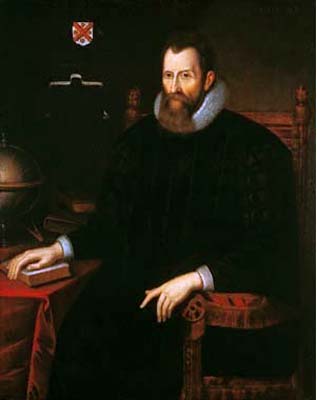

Portrait of John Napier (1550-1617), dated 1616.
Tables of numbers related in a very similar way were first published in 1614 by the mathematician, physicist and astronomer John Napier in a paper called The construction of the wonderful canon of logarithms. Surprisingly, though, Napier had never even heard of the number e, nobody had at the time, and he wasn't really thinking about exponentiation either. When he inadvertently defined something very similar to the logarithm to base e, he did so by imagining points moving along lines!
One problem that was plaguing people at the time, especially astronomers, was arithmetic. Astronomical calculations required the multiplication and division of very large numbers, something that's pretty hard to do without a calculator. One way of making things easier is to think in terms of powers. As the rules of exponentiation tell us, to multiply two powers of 2, say $2^a \times 2^b$, you only need to add their exponents. To divide them, you simply subtract their exponents: $2^a \times 2^b = 2^{a+b}$ $\frac{2^a}{2^b} = 2^{a-b}.$ So a table telling you how to express large numbers as powers of 2, or of any other number, would help you simplify your calculations considerably. Given a number $N$ you would be looking for the number $L$ so that $$N=2^L.$$In other words, what you'd want are tables of logarithms to the base 2, or some other number.
In Napier's time, however, people were not used to thinking in terms of exponentiation. They didn't have the concept of a base and they didn't have our handy way of writing powers, using a little number at the top.
What they were aware of, though, since the time of Archimedes, was an interesting link between the sequence you get by starting with 2 and successive doubling (which we today recognise as the sequence of powers of 2):
2, 4, 8, 16, 32, 64, 128, … .
and the sequence of natural numbers
1, 2, 3, 4, 5, 6, 7, … .
The first sequence is called a geometric progression because successive numbers have the same ratio; 2. The latter is called an arithmetic progression because successive numbers have the same difference; 1.
People noticed that multiplying (or dividing) two numbers in the geometric progression corresponds to adding (or subtracting) the corresponding numbers in the arithmetic progression. (To us, these are just the laws of exponentiation again, as numbers in the geometric progression are powers of 2, and the numbers in the arithmetic progression are the corresponding exponents.) This seemed to offer a way of making calculations easier, as you could replace the harder operations in the geometric progression with easier ones in the arithmetic progression.
Napier wanted to produce a table that related numbers in a useful geometric progression to numbers in a corresponding arithmetic progression so that, as he wrote, "All multiplications, divisions and [...] extraction of roots are avoided," and replaced by "most easy additions, subtractions and divisions by 2."
It's the way he found the two sequences that is so intriguing. Imagine a point, call it $P$, moving along a finite line segment from a point $A$ to a point $B.$ It doesn't move at uniform speed, however, but slows down continually: its speed at any given moment is proportional to the distance still left to travel to the point $B$. The closer to $B$ the point gets, the slower it gets, so it will never actually reach $B$. If you measured the distance still left to travel to $B$ at regular time intervals, say every second, then the numbers you'd get would form a decreasing geometric progression: ratios between successive numbers would be equal, but unlike on our example above, they'd be smaller than 1.

Today we would use calculus to work out Napier's logarithm. If you do this (see here to find out how), you will find that
$$\frac{x}{10^7} = \frac{1}{e}^{\left(\frac{y}{10^7}\right)},$$ where $x$ is the distance still to travel by $P$ and $y$ is the distance already travelled by $Q.$ This means that $\frac{y}{10^7}$ is the logarithm to base $1/e$ of $\frac{x}{10^7}$ — essentially that's what Napier's construction defines. But since calculus had not been invented in Napier's time, his table gave an approximation of this logarithm, relating $x$ and $y$ by the relationship $$\frac{x}{10^7} =\left(1-\frac{1}{10^7}\right)^y.$$ To see that this really is a good approximation, rewrite the expression as $$\frac{x}{10^7} = \left(1-\frac{1}{10^7}\right)^{10^7\left(\frac{y}{10^7}\right)}.$$ If you are familiar with the many beautiful properties of the number $e$, then you will know that for any real number $x$, $e^{x}$ is the limit as $n$ goes to infinity of $$\left(1+\frac{x}{n}\right)^{n}.$$ Taking $x=-1$ gives $$\lim_{n \rightarrow \infty}{\left(\left(1-\frac{1}{n}\right)^{n}\right)} = e^{-1}=\frac{1}{e}.$$ And since $10^7$ is a very large number, the number $$\left(1-\frac{1}{10^7}\right)^{10^7}$$ that appears as the base in Napier's logarithms is very close to the limit $\frac{1}{e}$. Therefore, since $$\frac{x}{10^7} = \left(1-\frac{1}{10^7}\right)^{10^7\left(\frac{y}{10^7}\right)},$$ $\frac{y}{10^7}$ is very close to the logarithm to base $\frac{1}{e}$ of $\frac{x}{10^7}$. That's why Napier's work is often counted as the first, albeit implicit, appearance of the number $e$ in mathematical history. And Napier is today credited with inventing the natural logarithm — without ever having heard of $e!$About the author
Marianne Freiberger is Editor of Plus.